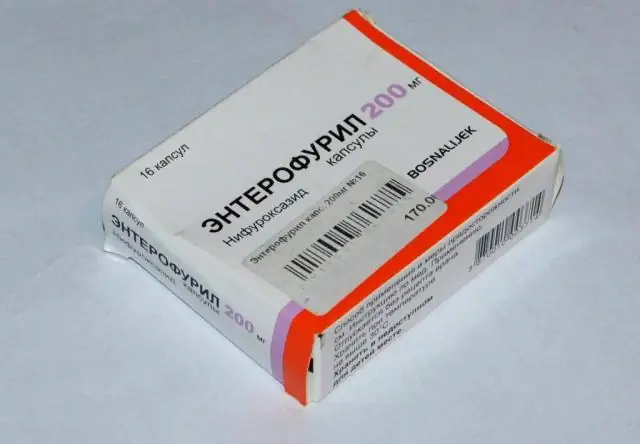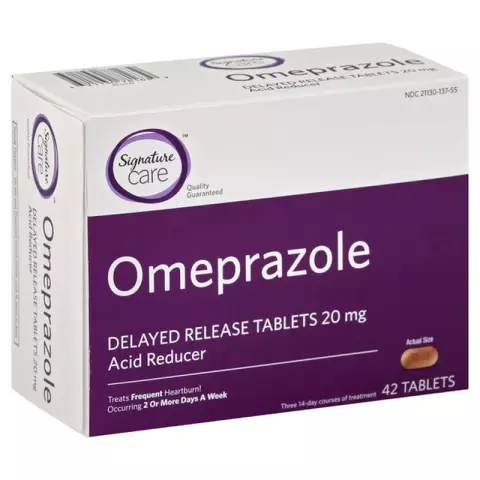- Author Rachel Wainwright [email protected].
- Public 2023-12-15 07:39.
- Last modified 2025-11-02 20:14.
Omeprazole-OBL
Omeprazole-OBL: instructions for use and reviews
- 1. Release form and composition
- 2. Pharmacological properties
- 3. Indications for use
- 4. Contraindications
- 5. Method of application and dosage
- 6. Side effects
- 7. Overdose
- 8. Special instructions
- 9. Application during pregnancy and lactation
- 10. Use in childhood
- 11. In case of impaired renal function
- 12. For violations of liver function
- 13. Drug interactions
- 14. Analogs
- 15. Terms and conditions of storage
- 16. Terms of dispensing from pharmacies
- 17. Reviews
- 18. Price in pharmacies
Latin name: Omeprazole-OBL
ATX code: A02BC01
Active ingredient: Omeprazole (Omeprazole)
Producer: JSC "Pharmaceutical Enterprise" Obolenskoe "(Russia)
Description and photo update: 2019-14-10
Prices in pharmacies: from 89 rubles.
Buy

Omeprazole-OBL - a drug that reduces gastric secretion; proton pump inhibitor.
Release form and composition
Dosage form - capsules: transparent, size No. 2, colorless with pink transparent caps, inside filled with white or almost white pellets (10 or 20 capsules in cell contour packs, in a cardboard box 1, 2 or 3 packs; 7 capsules per packs of cell contour, in a pack of cardboard 2 or 3. Each pack also contains instructions for the use of Omeprazole-OBL).
Composition of 1 capsule:
- active substance: omeprazole - 20 mg;
- auxiliary components: tween-80, titanium dioxide, talc, sodium lauryl sulfate, sodium hydroxide, polyvinylpyrrolidone K-30, polyethylene glycol 6000, sucrose (sugar syrup), sugar pellets (sucrose), mannitol, hypromellose (hydroxypropyl methylcellulose), potassium, disubstituted calcium phosphate carbonate;
- pellet shell: acrylic coating L30D;
- capsule shell: acetic acid, propyl parahydroxybenzoate, methyl parahydroxybenzoate, gelatin, azorubin.
Pharmacological properties
Pharmacodynamics
Omeprazole-OBL is an antiulcer drug, proton pump inhibitor (hydrogen-potassium adenosine triphosphatase - H + / K + ATP). The drug inhibits the activity of H + / K + ATP in the parietal cells of the stomach, thereby blocking the transfer of hydrogen ions and the final stage of the synthesis of hydrochloric acid in the stomach.
The active substance Omeprazole-OBL (omeprazole) is a prodrug. Getting into the acidic environment of the tubules of parietal cells, it turns into an active metabolite - sulfenamide, which, through a disulfide bridge, combines with the membrane H + / K + ATP and inhibits it. This determines the high selectivity of the action of the substance precisely on the parietal cells, in which there is an environment for the formation of sulfenamide.
Omeprazole is rapidly, within 2-4 minutes, biotransformed into sulfenamide. The active metabolite of the drug is a cation and does not undergo absorption.
The drug inhibits the release of pepsin, lowers the total volume of gastric secretion, suppresses at the final stage the secretion of hydrochloric acid
(basal and stimulated by any stimulus). It has gastroprotective activity, the mechanism of which has not yet been clarified.
Taking omeprazole does not affect the rate of transition of the food mass from the stomach to the duodenum, the production of glycomcoprotein (Castle's internal factor), and also does not affect histamine and acetylcholine receptors.
The capsule contains microgranules (pellets), which are coated. After 1 hour after taking them, the active substance begins to gradually be released and exert an effect. The maximum therapeutic effect is observed after 2 hours and lasts for 24 hours or more.
After a single dose of 20 mg omeprazole, inhibition of ½ of the maximum secretion continues for 24 hours.
A single use of Omeprazole-OBL per day promotes rapid and effective inhibition of daytime and nocturnal gastric secretion, which reaches its maximum after 4 days of therapy.
Taking 20 mg of the drug against the background of duodenal ulcer maintains a pH of 3 inside the stomach for 17 hours.
Pharmacokinetics
Omeprazole is highly absorbed. Its bioavailability varies from 30 to 40%, increases with liver dysfunction and in elderly patients; against the background of liver failure, it increases to almost 100%. Renal function does not affect the bioavailability of the substance. The maximum concentration in the blood is observed after 0.5-3.5 hours after taking Omeprazole-OBL.
Due to its high lipophilicity, the drug easily penetrates into the parietal cells of the stomach. Its connection with plasma proteins is from 90 to 95% (albumin / acid alpha1-glycoprotein), and the half-life is from 0.5 to 1 hour (in patients with liver failure it increases to 3 hours).
The clearance of omeprazole varies from 500 to 600 ml per minute. Its metabolism is almost completely carried out in the liver with the participation of the CYP2C19 enzyme system. In this case, 6 pharmacologically inactive metabolites are formed - sulfonic and sulfide derivatives, hydroxyomeprazole and others. Omeprazole-OBL is an inhibitor of the CYP2C19 isoenzyme.
Omeprazole is excreted by 70-80% through the kidneys and by 20-30% with bile in the form of metabolites. Excretion in patients with chronic renal failure decreases in proportion to the decrease in creatine clearance.
In elderly patients, the bioavailability of the substance increases, and its excretion decreases.
Indications for use
- peptic ulcer of the stomach and duodenum - with exacerbation of the pathology and as anti-relapse therapy, including associated with Helicobacter pylori (as part of a combination treatment);
- reflux esophagitis, including erosive;
- hypersecretory states - systemic mastocytosis, polyendocrine adenomatosis, stress ulcers of the gastrointestinal tract, Zollinger-Ellison syndrome;
- gastropathy, which resulted in the use of non-steroidal anti-inflammatory drugs (NSAIDs).
Contraindications
Absolute:
- pregnancy;
- period of breastfeeding;
- children under the age of 18;
- individual intolerance to the components of the drug.
Relative (Omeprazole-OBL is prescribed under medical supervision): renal failure, liver failure.
Omeprazole-OBL, instructions for use: method and dosage
Omeprazole-OBL capsules are taken orally, usually in the morning, before meals, without chewing and drinking water (a small amount).
Recommended dosage regimen:
- exacerbation of gastric ulcer and duodenal ulcer, reflux esophagitis, gastropathy caused by taking NSAIDs: 1 capsule per day;
- severe reflux esophagitis: 2 capsules a day;
- Zollinger-Ellison syndrome: 3 capsules a day, with a possible dose increase to 4-6 capsules a day, divided into 2-3 doses;
- relapses of gastric ulcer and duodenal ulcer: ½ capsule per day.
The duration of therapy, depending on the disease, is:
- duodenal ulcer: from 14 to 28 days with a possible extension of up to 35 days;
- peptic ulcer, reflux esophagitis, erosive and ulcerative lesions of the gastrointestinal tract caused by taking NSAIDs: from 28 to 56 days. A decrease in the manifestations of pathology and ulcer scarring is usually observed within 14 days. In case of incomplete scarring of the ulcer after taking Omeprazole-OBL for 14 days, the therapy is extended for another 14 days.
Patients who are resistant to treatment with other anti-ulcer drugs take 2 capsules daily. In such cases, the duration of treatment depends on the pathology and is four weeks for duodenal ulcer, and eight weeks for gastric ulcer and reflux esophagitis.
In order to eradicate Helicobacter pylori, triple or double therapy is recommended. In the first case, the patient is prescribed one of the following combinations of drugs for 7 days:
- scheme I (2 times a day): Omeprazole-OBL - 1 capsule + amoxicillin - 1 g + clarithromycin - 0.5 g;
- scheme II (2 times a day): Omeprazole-OBL - 1 capsule + clarithromycin - 0.25 g + metronidazole - 0.4 g;
- scheme III (3 times a day): Omeprazole-OBL - 2 capsules + amoxicillin - 0.5 g + metronidazole - 0.4 g.
In the second case, patients take one of the following drug combinations for 14 days:
- scheme I (2 times a day): Omeprazole-OBL - 1 or 2 capsules + amoxicillin - 0.75 g;
- scheme II (3 times a day): Omeprazole-OBL - 2 capsules + clarithromycin - 0.5 g;
- scheme III (2 times a day): Omeprazole-OBL - 2 capsules + amoxicillin from 0.75 to 1.5 g.
Patients with hepatic impairment are prescribed ½ - 1 capsule per day. In cases of severe renal failure, the maximum daily dose should not exceed 1 capsule.
Correction of the dosage regimen for elderly patients and patients with impaired renal function is not required.
Side effects
Possible adverse reactions of Omeprazole-OBL (> 10% - very common;> 1% and 0.1% and 0.01% and <0.1% - rarely; <0.01%, including isolated messages - very rare):
- digestive system: flatulence, vomiting, nausea, abdominal pain, diarrhea / constipation; rarely - taste disturbances, increased activity of hepatic transaminases; in some cases - stomatitis, dry mouth; against the background of previous severe liver pathology - liver dysfunction, hepatitis, with jaundice inclusive;
- nervous system: with severe concomitant somatic diseases - depression, agitation, headache, dizziness; with previous severe liver pathologies - encephalopathy;
- musculoskeletal system: in some cases - myalgia, myasthenia gravis, arthralgia;
- hematopoietic system: in some cases - pancytopenia, agranulocytosis, thrombocytopenia, leukopenia;
- skin: rarely - itching and / or rash; in some cases - alopecia, exudative erythema multiforme, photosensitization;
- allergic reactions: fever, urticaria, bronchospasm, interstitial nephritis, angioedema, anaphylactic shock;
- others: rarely - increased sweating, peripheral edema, visual impairment, malaise, gynecomastia; with prolonged use of Omeprazole-OBL - the formation of gastric glandular cysts due to inhibition of HCl secretion (it is benign, reversible).
Overdose
The main symptoms of an overdose of Omeprazole-OBL: nausea, drowsiness, headache, dry mouth, arrhythmia, tachycardia, blurred vision, confusion.
In case of intoxication, symptomatic treatment is recommended. Prescribing hemodialysis is not effective enough.
special instructions
It is important to exclude the presence of a malignant process before taking Omeprazole-OBL, especially in patients with stomach ulcers. This is due to the fact that the ongoing therapy, masking the manifestations of pathology, can delay the correct diagnosis.
Food intake does not affect the effectiveness of the drug.
Application during pregnancy and lactation
Omeprazole-OBL is not prescribed during pregnancy / lactation.
Childhood use
For patients under 18 years of age, the drug is not prescribed.
With impaired renal function
Omeprazole-OBL capsules are used with caution in patients with renal insufficiency.
For violations of liver function
Omeprazole-OBL is prescribed with caution in liver failure.
Drug interactions
Possible interactions of omeprazole with other substances / drugs:
- ketoconazole, itraconazole, iron salts, ampicillin esters: their absorption may decrease (since omeprazole increases the pH of the stomach);
- phenytoin, indirect anticoagulants, diazepam (drugs whose metabolism occurs in the liver with the participation of cytochrome CYP2C19): their concentration may increase and excretion may decrease (since omeprazole is an inhibitor of cytochrome P450. In some cases, a decrease in doses of these drugs may be required.
Long-term therapy with omeprazole at a dose of 1 capsule per day in combination with estradiol, quinidine, lidocaine, cyclosporine, ethanol, propranolol, metoprolol, naproxen, diclofenac, piroxicam, theophylline and caffeine did not lead to a change in the concentration of these drugs in blood plasma.
Omeprazole enhances the inhibitory effect on the hematopoietic system of other drugs. With the simultaneous use of antacids, no interactions were noted.
Analogs
Omeprazole-OBL analogs are Omez, Losec MAPS, Omal, Gastrozol, OmeVel, Ultop, Losek, Romesek, Pleom-20, Omizak, Helicid, Omeprazol-Ukea, Ulkozol, Omitox, Promez, Tsisagast, Omeprazol-Richter, Or.
Terms and conditions of storage
Store in a place protected from light and moisture at temperatures up to 25 ° C. Keep out of the reach of children.
The shelf life is 3 years.
Terms of dispensing from pharmacies
Dispensed by prescription.
Reviews of Omeprazole-OBL
According to reviews, Omeprazole-OBL is a safe, effective and affordable drug used in the treatment of gastritis, stomach ulcers and reflux esophagitis. Among the shortcomings, they mainly note the presence of contraindications to the use of the drug, as well as the development of side effects against the background of its administration.
Price for Omeprazole-OBL in pharmacies
The approximate price for Omeprazole-OBL, 20 mg capsules, 28 pcs in a package, ranges from 89.8 to 113 rubles.
Omeprazole-OBL: prices in online pharmacies
|
Drug name Price Pharmacy |
|
Omeprazole-OBL 20 mg capsules 28 pcs. 89 RUB Buy |
|
Omeprazole-OBL capsules 20mg 28 pcs. 119 RUB Buy |

Anna Kozlova Medical journalist About the author
Education: Rostov State Medical University, specialty "General Medicine".
Information about the drug is generalized, provided for informational purposes and does not replace the official instructions. Self-medication is hazardous to health!






